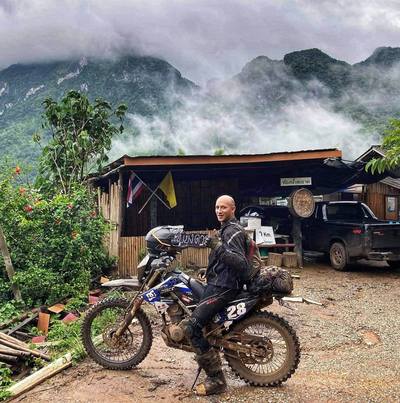Having proper gear can reduce motorcycle injuries by protecting riders and passengers from trauma sustained through crashes and road rash.
Quality gear is vital in a motorcycle accident as sub-standard gear may not be able to stand up to blunt-force trauma or the high levels of friction that can occur if a rider or passenger slides across a road surface.
Common Motorcycle Injuries
Motorcycle injuries can vary in severity, but almost all have the potential to be serious.
The open design of a motorcycle means riders and passengers do not enjoy the same level of protection or safety features found in most automobiles.
Common injuries from motorcycles can include head injuries or traumatic brain injuries (TBIs), injuries to the spine or spinal cord, scrapes or road rash and bone breaks and fractures. The speed at which a motorcycle travels during an accident can often determine the severity of injuries sustained during the accident.
Road rashes
Road rash is a term used to describe topical injuries that occur when a motorcycle rider or passenger falls off a bike but remains in motion while sliding across the ground. Because motorcycles do not have seat belts like passenger vehicles, drivers and passengers can continue to travel at high rates of speed after a crash has caused a bike to come to a complete stop.
When this occurs, the person continues to travel in the direction the bike is headed, often sliding across the ground. This sliding causes friction, and the hardness and texture of road surfaces can scrape away skin as a person moves across it. The result can be a severe injury to the skin, soft tissue, and even bone. Protective leather jackets, pants, chaps, gloves, and other safety gear can help reduce the potential for road rash in a motorcycle crash.
Traumatic brain injuries

Traumatic brain injuries are the result of head trauma. When the head hits a hard surface, the brain bounces around inside the skull. This can injure the brain and cause lasting damage that may not heal with time or even surgery and medication. TBIs can be present even if no external head injury is apparent.
A traumatic brain injury can lead to cognitive disabilities, processing disorders and even paralysis. According to the National Institute of Neurological Disorders and Stroke, recovering from a TBI can require lifelong therapy, and these types of injuries may eventually lead to death.
Severe injuries
Severe injuries from motorcycle accidents can develop in various places around the body, including internal organs. Ruptures and tears may lead to internal bleeding, organ dysfunction and other internal injuries that can produce severe and life-threatening results.
Fractures and soft tissue injuries
Bone fractures and injuries to soft tissue like muscle can result from motorcycle accidents. These types of injuries may be caused by the initial impact after falling off a motorcycle, but they can also come from secondary impacts suffered after rolling or sliding across ground surfaces following a crash.
Fractures and soft tissue injuries may not be apparent in the immediate aftermath of a motorcycle crash. For this reason, it’s important to be checked out by a doctor after a motorcycle accident even if you haven’t noticed any outward injuries. Continuing to walk and take part in daily activities while suffering from fractures and soft tissue injuries may make these problems worse.
Eye injuries
Eye injuries can arise from motorcycle crashes for several reasons. First, a crash may result in a rider or passenger landing face-first on the ground or another hard surface. Second, debris that gets kicked up during a crash could impact the eyes. Third, fluids from the motorcycle itself may splash into the eyes during a crash.
Eye protection is also important when riding to protect against road debris, bugs and other things floating in the air. Due to the high rate of travel that usually comes with operating a motorcycle, small things in the air can hit an exposed face with a lot of force. If a bug happens to hit your eye while operating a motorcycle, it can hit with a lot of force, potentially causing injury.
Importance of Protective Gear
Because motorcycle accidents can result in severe injuries and even death, riders and passengers need to wear the right safety gear. According to the National Safety Council, consistently wearing safety gear has been shown to prevent injuries or reduce the severity of injuries in the event of a motorcycle crash.
List of Recommended Protective Gear
Every rider or passenger of a motorcycle is encouraged to familiarize themselves with protective gear in order to choose the right items. Protective gear should be worn whenever you are on a motorcycle in motion.
Helmets
A proper helmet can protect the head and, in some cases, face of motorcycle riders and passengers. According to the National Highway Traffic Safety Administration (NHTSA), you should choose a helmet based on size and fit, but you should also look for a Department of Transportation (DOT) symbol on the back of the helmet. This symbol signifies that the helmet meets the safety standards set forth by the DOT.
Jackets
Jackets protect against road rash in the event that a rider or passenger falls off a bike during the course of a motorcycle crash; however, not just any jacket will do. Motorcycle riders are encouraged to wear thick jackets made from materials like leather to protect against injuries.
Thinner and lighter materials will not be able to stand up to the friction and tearing that can occur during a slide following a motorcycle crash. Thick leather will not wear away as easily and can typically withstand and protect against friction that would otherwise cause road rash.
Boots
Motorcycle boots can protect the feet and ankles during a crash, but they can also protect riders and passengers against burns. The muffler of a motorcycle can become incredibly hot during operation, and placing exposed skin on the muffler while it is hot can result in serious burns. Tall motorcycle boots can protect the ankles and lower shin area against burns from accidentally touching your leg against a motorcycle muffler.
Gloves

Protective gloves can prevent injuries to the hands following a motorcycle crash. They can also aid in grip during the operation of a motorcycle, potentially preventing accidents in the first place.
Most motorcycles are operated using a throttle that is contained in one of the handlebar grips. The brake of the motorcycle is also contained in this area in a handle that is squeezed. Gripping gloves can aid riders in proper operation and prevent mistakes that can lead to accidents.
Eye protection
Eye protection for motorcycle riders is available in the form of glasses or goggles as well as face shields that are attached to a helmet. Ensuring eye protection can help avoid eye and face injuries due to road debris, bugs and other things in the air. Eye protection can also protect you in the event of a crash to keep road debris out of your eyes, and helmet face shields can prevent your face from making contact with surfaces in the event of a crash.
How Proper Gear Reduces Injuries
Proper motorcycle safety gear reduces injuries during crashes in several ways depending on the type of gear and type of crash.
Head protection
Head protection in the form of helmets can reduce the potential for head, face and, in some cases, neck injuries following a motorcycle accident. Helmets need to be certified by the DOT and allow for easy viewing of the road and nearby surroundings. A helmet that obscures vision can actually be a danger to motorcycle riders.
It’s important to note that a helmet does not completely stop impacts to the head. A motorcycle rider who crashes into a wall at a high rate of speed may still suffer injuries to the brain due to the impact. A helmet may, however, lessen injuries sustained to the head during a motorcycle accident.
Abrasion resistance
Any type of protective gear worn while riding a motorcycle should be resistant to abrasions. Leather jackets, for example, can protect against road rash, and some riders also wear leather chaps to protect their legs in the event of a crash. Abrasions from motorcycle accidents can be severe and may even scrape the skin down to the level of soft tissue or bone.
Impact absorption
As mentioned above when discussing the use of helmets, protective motorcycle gear should contain impact absorption properties when possible. Helmets are the best example of this, but some innovative companies have developed motorcycle airbags in recent years.
These are inflatable devices that fill up with air upon impact. They may lessen the severity of impacts, but they will not completely protect against high-speed crashes.

Visibility enhancement
Because motorcycles are smaller than commuter vehicles, they may not be seen as easily when on the road. This can be a safety risk, and so motorcycle riders are encouraged to use safety gear that enhances visibility.
Things like reflective vests or other reflective clothing can be good for improving visibility, and ensuring headlights and taillights are in good working order is also essential for safety.
Importance of Wearing a Helmet
The importance of wearing a helmet while riding or being the passenger of a motorcycle cannot be overstated. Helmets save lives, and anyone who is on a moving motorcycle needs to wear one. Helmets protect against injuries in the event of a crash, but they also provide additional protective benefits.
Road debris and bugs in the air can cause injuries while riding a motorcycle without a helmet. Wind and wind noise can also cause motorcycle riders to become unaware of nearby threats. Helmets protect against these hazards in addition to providing protection in the event of an accident.
Motorcycle Accidents
If you were involved in a motorcycle accident, you could receive compensation. Contact a local lawyer who can guide you with the legal process. Compensation could cover things like hospital bills, doctor visits, rehabilitation and any other medical treatment related to the accident.
ABOUT THE AUTHOR
Olivia Poglianich
Content Strategist
Olivia Poglianich is a nomadic brand strategist and copywriter in the motorcycling and adventure space who has worked with brands such as Visa, Disney and Grey Goose. Her writing has taken her all over the world, from a Serbian music festival to a Malaysian art and culture event. Olivia is a graduate of Cornell University and is often writing or reading about travel, hospitality, the start-up ecosystem or career coaching. Her latest interests are at the intersection of web3 and communal living, both on and offline.






